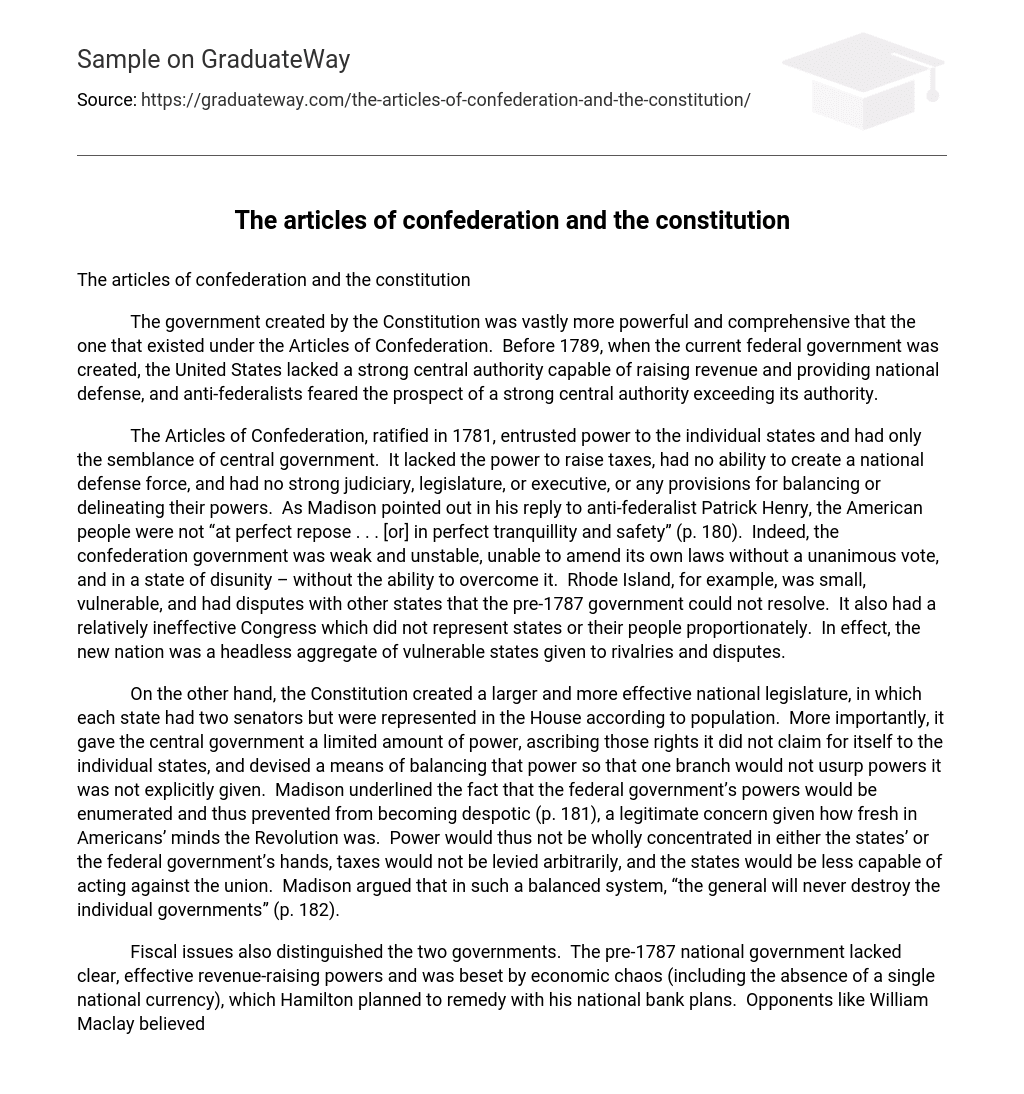The government created by the Constitution was vastly more powerful and comprehensive that the one that existed under the Articles of Confederation. Before 1789, when the current federal government was created, the United States lacked a strong central authority capable of raising revenue and providing national defense, and anti-federalists feared the prospect of a strong central authority exceeding its authority.
The Articles of Confederation, ratified in 1781, entrusted power to the individual states and had only the semblance of central government. It lacked the power to raise taxes, had no ability to create a national defense force, and had no strong judiciary, legislature, or executive, or any provisions for balancing or delineating their powers. As Madison pointed out in his reply to anti-federalist Patrick Henry, the American people were not “at perfect repose . . . [or] in perfect tranquillity and safety” (p. 180). Indeed, the confederation government was weak and unstable, unable to amend its own laws without a unanimous vote, and in a state of disunity – without the ability to overcome it. Rhode Island, for example, was small, vulnerable, and had disputes with other states that the pre-1787 government could not resolve. It also had a relatively ineffective Congress which did not represent states or their people proportionately. In effect, the new nation was a headless aggregate of vulnerable states given to rivalries and disputes.
On the other hand, the Constitution created a larger and more effective national legislature, in which each state had two senators but were represented in the House according to population. More importantly, it gave the central government a limited amount of power, ascribing those rights it did not claim for itself to the individual states, and devised a means of balancing that power so that one branch would not usurp powers it was not explicitly given. Madison underlined the fact that the federal government’s powers would be enumerated and thus prevented from becoming despotic (p. 181), a legitimate concern given how fresh in Americans’ minds the Revolution was. Power would thus not be wholly concentrated in either the states’ or the federal government’s hands, taxes would not be levied arbitrarily, and the states would be less capable of acting against the union. Madison argued that in such a balanced system, “the general will never destroy the individual governments” (p. 182).
Fiscal issues also distinguished the two governments. The pre-1787 national government lacked clear, effective revenue-raising powers and was beset by economic chaos (including the absence of a single national currency), which Hamilton planned to remedy with his national bank plans. Opponents like William Maclay believed that a strong federal government would plunder states’ coffers and leave them impoverished (p. 183), and that a national bank would exceed its powers, but Hamilton argued that the Constitution allowed corporations as long as they served the national interest and that a national bank would allow the government to create a stable currency and raise capital. Anti-federalists also envisioned a Jeffersonian America of yeoman farmers, small merchants, and virtually no central government, equating the pastoral life to godliness and believing that the manufacturing and financial economy Hamilton envisioned would bring corruption and loss of freedom (pp. 193-194). The federalists believed that the United States needed a strong, diverse, modern economy in order to stay viable.
The Constitution’s creators would likely be pleased to see their model for the federal government survive for over two centuries. Hamilton’s vision of the American economy has endured and expanded, and the system of checks and balances it proposed has generally worked well. While they may object to the current government’s sheer size, as well as with some of the laws the Constitution now includes (such as slavery’s abolition and universal adult suffrage), they would likely be pleased to see both the republic they created endure.





